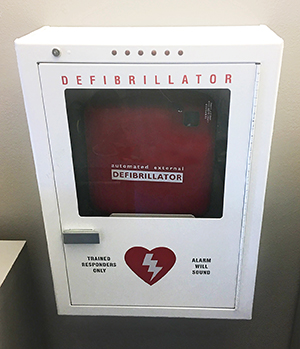Automated External Defibrillator

When someone’s heart stops working, it's known as sudden cardiac arrest. Sudden cardiac arrest happens to many thousands of people each year. It causes blood to stop flowing to the brain and other organs. Without rapid treatment, a person will die within minutes. In some cases, an automated external defibrillator (AED) may save a person’s life.
What is an automated external defibrillator?
An AED is a small, portable, battery-powered machine with a computer in it. The machine detects heart activity. It can give an electric shock to someone if needed. It uses small sticky gel pads called electrodes that are put on a person’s body. The electrodes are attached to wires. The wires send information from the body to the AED machine. The machine checks the heart’s electrical system. If certain kinds of abnormal heart rhythms (arrhythmias) are found, the machine can give the person an electric shock. This shock can reset the heart’s electrical activity and cause it to beat normally again.
How does an AED work?
The heart has its own electrical system. It controls how the heart contracts and pumps blood—or “beats.” Heartbeats are known as the heart rhythm. But sometimes a person can have abnormal heartbeats. These are known as arrhythmias. Some kinds of dangerous arrhythmias can cause sudden cardiac arrest. One dangerous arrhythmia is ventricular fibrillation. This causes the heart’s lower chambers to flutter wildly instead of pump. They can’t move blood out of the heart when this happens. Another dangerous arrhythmia is called ventricular tachycardia. This causes the heart’s lower chambers to pump too fast. It can also cause the heart to not pump blood out of the heart.
An AED can detect these arrhythmias. It can then give an electric shock to the heart. This can help it stop an abnormal rhythm and restart a normal heart rhythm that pumps blood normally.
Using an AED
Anyone can use an AED. Many people—such as first responders, flight attendants, and people who work in large public facilities—are trained to use an AED. But AEDs are also made to be used by people with no training. This is because it can save a person’s life in minutes. There may not be time to find someone who has training. All AEDs come with instructions. Many AEDs tell the user what to do with voice commands and make the use as simple as possible. In many instances, all you have to do is turn on the AED and place the AED electrodes on the person. The AED will automatically detect the heart's activity and either deliver a shock or determine that no shock is needed. Whenever you are in a public place, look for an AED station. It could save someone's life.
AEDs are found in many public places where a person may have sudden cardiac arrest:
-
Airports and airplanes
-
Ambulances
-
Casinos
-
Convention centers
-
Cruise ships
-
Fire engines
-
Grocery stores
-
Hotels
-
Offices
-
Police vehicles
-
Public pools
-
Schools
-
Shopping malls
-
Sports arenas
-
Trains and buses
It's important to remember that an AED does not replace CPR. It's used in addition to CPR. If a person is unresponsive and not breathing, you need to call for help and start CPR. Don't delay CPR while waiting for someone to get an AED. An AED can be placed on a person during a pause in CPR. Providing CPR may provide enough blood flow until an AED can shock a person's heartbeat into a normal rhythm.
You can also buy and learn to use an AED at home. You can find an AED training class in your area by contacting the American Heart Association at 800-242-8721.